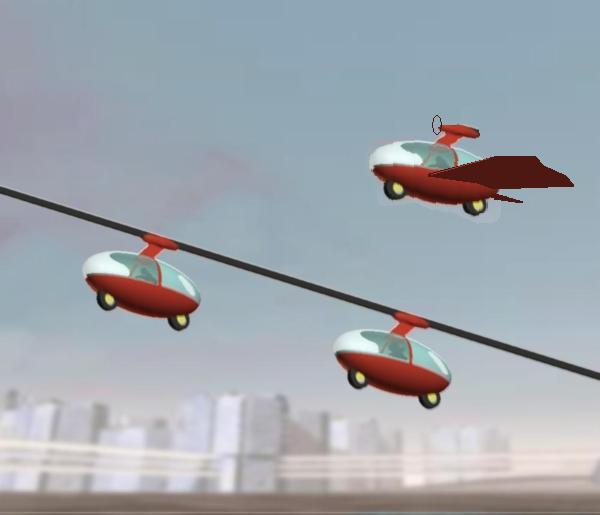BY LETTER
MultiModal Personal Rapid Transport
Technology > Technology Type or Material > Drytech/Hylotech
Technology > Application > Everydaytech
Technology > Technology Levels > Middle Tech / Midtech
Technology > Application > Transportation > Surface Transport
Technology > Application > Everydaytech
Technology > Technology Levels > Middle Tech / Midtech
Technology > Application > Transportation > Surface Transport
AKA Pods, People Pods | |
 Image from Steve Bowers | |
| these small vehicles can utilise a number of different modes | |
Multimodal Personal Rapid Transport devices are small automated vehicles which enable a single individual, or in some cases a small number of persons (often sitting in tandem) to travel rapidly from one location to another. MPRTs are generally smaller than any other mode of transport, apart from archaic motorcycles and bicycles.
MPRTs often have two wheels in line beneath the passenger accommodation, so resemble the motorcycle concept in some ways. Other designs have three or four wheels, or even a gyroscopically stabilised single wheel. Because a typical MPRT can achieve quite high speeds, the passenger compartment is generally enclosed and streamlined, although some examples expose the passenger to the elements to some extent (this is a matter of consumer choice; most MPRTs are subject to extreme safety standards). Because of the streamlined casing many MPRTs are known as Pods (sometimes People Pods).
Once in motion a modern MPRT can travel for many kilometers over quite extreme terrain on its complement of wheels; but if the appropriate infrastructure is available the MPRT can travel within a fixed route known as a guideway, or may deploy equipment for traveling on maglev tracks. In a three-dimensional environment many pod designs deploy equipment for traveling within vertical shafts, allowing a Pod to move freely between levels and to the highest or lowest floors of a city. This infrastructure of guideways and liftshafts is the defining feature of a MPRT system
When traveling long distances on a maglev system the Pod may be incorporated within a larger vehicle, conventional train or vactrain, and quite often the passenger can exit the pod and move about within the larger vehicle to gain access to dining areas or other conveniences.
Some Pods can even be loaded onto aircraft or spacecraft, and some advanced designs can be used for transfer between spacecraft or space habitats. Many habitats and megastructures have appropriate guideways and shafts incorporated into the design, often on the outside of the structure.
MPRTs can also have add-on modules equipped with fixed wings, paramotors, fancloth wings, Fan matrix arrays, outboard motors, hydrojets or teraskele walking legs for use in specialized environments. Some expensive models can morph their external form to produce such accessories without the need for additional modules.
Because they are very light and use several different methods of locomotion, MPRTs can move individuals rapidly from almost any location on a planet to another location; they are extremely flexible in use and responsive to demand. Larger Multimodal designs are often called Transmodal Capsules or Transbuses, and may seat ten persons or more, or afford roomy accommodation for a smaller number; but the single person capsule is quite widespread because of its flexibility. Other forms of transport such as automobiles, robotaxis and vehvecs may also utilize multimodal transport infrastructure such as guideways and liftshafts if designed to do so; but in many cases the guideways cannot accommodate vehicles over a certain size.
One notable Personal Rapid Transport system is found on Lancer's world, where human-powered speedbikes are used in connection with an extensive guideway system.
The most advanced form of MPRT is the travel pod, found in hi-tech and ultratech polities; this uses polymorphic technology to form the pod on demand from the local infrastructure, a seat and protective bubble apparently rising directly out of the floor or wall and acting as a personal or multiperson transport device.
Related Articles
Appears in Topics
Development Notes
Text by Steve Bowers
Initially published on 23 January 2007.
Initially published on 23 January 2007.






